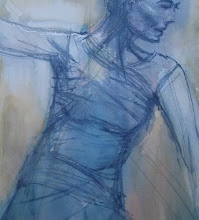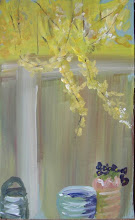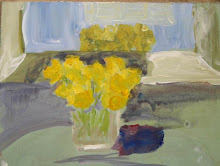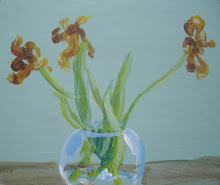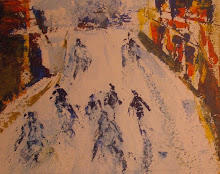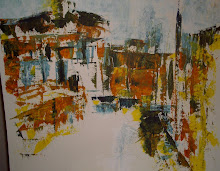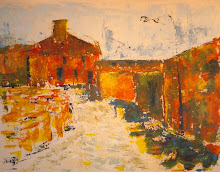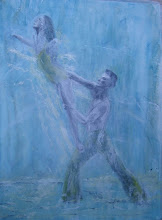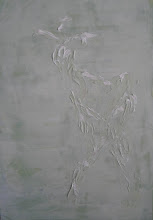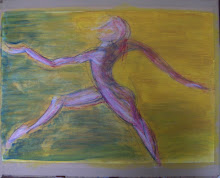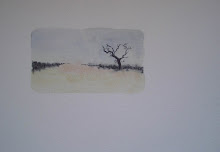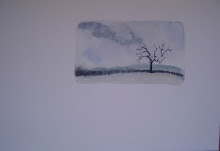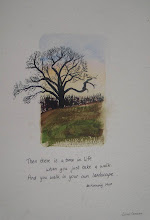Friday, 31 October 2008
Slade course
We made a paper box and cone, stuck them on paper and put them on the wall to draw. Homework is to draw a matchbox. I spent a week in Brazil at a conference, and some time waiting in my room passed happily drawing the box of shortbread I always take travelling to sustain, and the perfume bottle and box I bought on a whim on the plane. Whims are good, and healthy.
I recalled Giacometti - every time I look at what I am painting, it has changed. Even the shadows keep developing with looking. Strips of light appear in the matchbox's shadow, a darker line along the edge of what seemed dark before. Looking changes the seeing.
Getting the shadows 'right'
David Hockney in "Secret Knowledge", the film, said that, while a picture seen through a glass lens goes out of focus in the distance, what we see with our human eyes does not; it stays in focus, and is just far away. At least, I think that is what he said. It feels right too. When I look towards the wood, I feel that I can see the wood in focus and far away. I cannot see the details because they are too small, but I can see clearly what I can see. I talked about this with my artist friend, but I don't think she believed me,
Monday, 22 September 2008
New term, new class
Monday, 25 August 2008
More pictures
back to back to art
The vermillion picture was finished. I added lines that seemed to be needed and Roman vases found in Spain, now in the museum in Merida. The picture has the archaeological layers I wanted. It feels an odd creation, a strangeness.
Tuesday, 8 July 2008
Vermillion and a project
In the third art class, we started a "project". We began by mind mapping on a large sheet of paper in the middle of which we were to write or to think "what do I like to draw?". At the time, this question came as a loud and shocking reminder that we don't need permission to enjoy. What do I like, not what do I have to do or what should I do! It's okay to do something because I like doing it -- and actually I ought to do it just because I like doing it, and I'm likely to do it really well because I like doing it. (How to make this happen at work too?) Anyway, my mind map took in: the pleasure of drawing beautiful Greek statues, not as stone but as somehow alive; the lively beauty of the Roman pots and vases in the museum in Spain, placed on a shelf in a way that made them dance; and the beauty of the Latin writing inscribed in stone that could be read after 2000 years. I suppose there's a link with J. somewhere -- about human connections across time and through stone; we none of us survive physically but only through shared aesthetics and meanings. What we do or write or make may stay around and connect us to the future, even to future people not yet born; and this does nothing to take away present pain.
I pursued what was started in class by getting out books about Greek and Roman statues, old drawings. In one book there's a photograph of statues stacked in a museum in Lyon. There's a head at an angle raised to the light that gives a feeling of exultation or agony, a man's head and body that display strength and power, and in the background, other busts watching like an audience. Just as the little vases in the museum became a piece of art by accident, so this photograph is a beautiful picture as if by chance. I did a quick rough drawing to get the feel of where things were. Then I used yellow and green acrylic paint on top of the vermillion, and the pencil I love best -- Indigo watercolour -- to scratch through the paint, draw on the paint and mix with the paint. As usual, I was frustrated by some details, especially in the mouth and nose of the foremost head, and working on it lost some of the spontaneity of other parts of the painting.
Today as I vacuum cleaned underneath the easel, I decided it needed more layers and that I still want to try those dancing vases on the glass shelf in the museum -- and I think in the photograph is also an image of me reflected in the glass case in front of them -- layers across time. So I've added a wash of vermillion hue, very wet, over the painting but of course some of the yellow was so beautiful I didn't want to lose it, so I took out bits of the vermillion wash. I'll add another wash and then leave it until after my holiday.
Sunday, 6 July 2008
Accuracy, beauty, truth
We agreed that what we wanted to see in our pictures was some kind of "truth" about what we were painting, and that's what I was trying to get at in "accuracy".
I think there's a great commonality between achieving this in one's art and achieving it in the kind of research that I do. Both require mastery of technique combined with imagination and being open to possibilities.
The last class of the year
Clouds
One goal achieved -- the Rape Field painting, mounted and framed, was hung in a local exhibition.
In one class, we painted and drew clouds. First, just playing with materials and techniques, and then going outside to draw what was there. We've done a lot with various types of soluble pencils -- sometimes these produce nice effects, like rain out of a cloud, and other times they just annoy me because they're too small and fiddly. At home, I sat in the window seat and used watercolour pencils to paint the clouds over the pond. A couple of weeks after, I dashed to the seaside and spent some hours painting clouds over the Solent. They were yachts everywhere and I added some with my thin pen trying to get their jaunty movements. I took a photograph from where I was sitting, and am amused by how different the proportions are -- the little tiny strip of land has come out as quite mountainous in my painting.
Friday, 6 June 2008
Framed
sends his fluid soul
earthwards
along silver wires.
Earth-tethered, all of us.
framing - limiting
There's a kind of conflict going on between my art and my other professional work. In my professional arena I am an expert with a long list of publications and achievements; in the art I still feel like a beginner and only have a small set of paintings and drawings that could be made public, although hundreds of others lie in the backs of cupboards and in old sketch books. My professional expertise provides me with financial security but sometimes I'd rather live in a small house, spend less money, and live with the art. Having built up expertise in one field over 20 or so years, I feel very weary and it's hard to be excited these days. For me now art is fresh and lively. In my art I can be wild and free, and push myself to be wilder and freer. In my other work, I have to be precise and accurate and have to push myself to be more precise and more accurate. In my work, my cv frames me. It is wearing and wearying.
After a few hours, I do start to resist the framing of my paintings. I try to work out why I preferred them loose, with the ragged white edges left by removing masking tape, curling stiffly at odd angles, each in their own way. The framing has turned them into a different kind of object, made them kind of bourgeois, a decoration for the wall of a house,thereby losing something of the creative feel of the un-framed, un-bound, painting on paper. Before it was framed, there was always a possibility of more development; now it's frozen, covered with glass, hard edged, stopped. No more dynamics.
I wonder if there are other ways of preparing these for display that don't lose (oh! instead of lose the software typed the blues..) their immediacy. Perhaps I could just fix a ring on the back of the paper so that it could be hung on the wall? Of course, the painting would decay faster, get dusty or keep falling off the wall, but it would still have a life or be part of a life rather than separated away behind its glass and inside its wooden frame. I'll keep looking to see how others deal with this -- I notice that the gallery advertisements in the art magazine contain pictures but never frames.
Thursday, 22 May 2008
The moment of awe
Having stopped, it feels risky to restart because what produced the awe will disappear as soon as I make another mark. Inevitably I do start again and lose it. Perhaps I should stop at that point and keep those pictures?
This moment of awe occurred in the Giacometti workshop when I put the first marks of the model's face on to the charcoal ground. As you can see, I didn't leave it there - I produced a somewhat wooden picture several hours later!
Of all the pictures I drew that weekend, I really only liked the jug on its plinth, alone in the studio.
Form and space
I did experience the Giacometti phenomenon of the form changing shape the more you look at it and the more you draw it, and that helped understand his feeling that he could never capture what he was trying to.
Later on, I thought about how his images emerge from drawing line after line after line. The act of looking changes or what you see and notice; that means that the line you've just drawn is no longer quite right and you need to draw another line. Eventually through the overlapping of lines and the darkness that creates, we start to see an image that is amazingly accurate -- or that feels amazingly accurate at least. The multiple, shifting strokes on the paper produce a form that makes sense to the viewing eye (my software typed "viewing I").
I connect this to the metaphors I see in my language data. Forms in space; forms created through multiple, shifting strokes of language.
Another woman I knew is dying, I heard today. Too many. I thought about her life as I knew of it; caring, busy, enthusiastically reaching out for new experiences. (Now I am trying to type "thinking" and the software hears me say: Clinging Sinking...) Thinking led to wanting to paint and the thoughts led to vermillion that needed sparkling silver.
Help
Did you know that you can get Help any time by saying “Give me help”?
Tuesday, 6 May 2008
Rape field
There is a tree standing on the horizon as I look uphill, and further away the woods, always the woods. I sketch the position and the colours; I photograph near and distant; I try to absorb. I also pick a stem of the rape and carry it home, feeling guilty at taking one out of the millions. Back home, I paint, get frustrated, paint some more. I painted the stem, the single flower first – not well but enough to see the shape of it and the shading to ochre in the centre. Then a larger picture over several hours. It evolves and changes and gradually becomes something I want to see. I remember that layers of yellow will make it brighter, and paint over and over the field; I change from Process Yellow to Cadmium Yellow which is more jarring and more like; I struggle with the stalks, then make them work by painting the spaces between - dark, and then adding red to be even darker. The little triangle of the track (where the farmer sprayed to kill the rape and clear the footpath) seems to make itself and just needs a few scribs of grass added. (I invented “scrib” to mean a strand of dried grass or plant painted with a tiny gesture of a brush, dry on dry.)
I can see that one of the fields in the background could be a better shape; that the rape flowers nearest to the viewer could be better defined; that the right branch on the tree could be slimmer. But I am pleased with the way the picture shouts for attention, like the field .
Questions:
Why do I feel the need for an audience for my painting? especially when I find criticism so hard to take?
How can I progress with my art? by which I don’t (just) mean get better technically but something like go deeper or say more...
Do I need to study in a college? or just keep painting?
Why would my paintings ‘say’ anything to other people anyway?
If my work doesn’t progress, I know I would not want to carry on painting at this fairly mediocre level - why is that?
Sunday, 4 May 2008
The instinct to self-preservation
My father's dementia with Lewy bodies seems to have progressed. He was more than usually confused as to place -- not able to hold on to an understanding of where he was -- but worse was the paranoia, his conviction that he had been captured and was held in this unknowable place by people of evil intent. The doctor had prescribed sedatives for him to take when he wanted to but I knew that he wouldn't take them from the nurses, whom he suspected of holding him against his will and deliberately changing their uniforms in order to confuse him more. I sat close, held his hand and explained what the new medication was and how it might help. Struggling with the rigidity that comes with the disease, he lifted his head slightly and said, "Don't kill me."
I gulp and reassure him that this is not the intention and that he can trust us.
"I suppose there are two people I can trust", he says, meaning myself and my brother, and excluding the teams of people and look after him day and night.
The "don't kill me" was shocking to hear from the man who always kept his Do Not Resuscitate letter in his wallet, having made sure that everyone knew it was there and reflected his wishes; from the man who, in moments of respite from confusion, now spoke of himself as a waste of time. As I drove back from the hospital, I thought about this instinct to preserve one's own life no matter how pitiful it has become.
It is this instinct that had motivated him to crawl to the phone after he had fallen, disentangling his heavy and barely functioning legs from his walking frame and kitchen stool. It is this instinct that keeps the dying alive and diverts their diseases for a while. It must, I thought as I slowed to a halt at a dangerous road junction, have evolutionary advantages. Without the instinct of self-preservation, I wouldn't slow down; I wouldn't care if another car was coming because it wouldn't matter to me to stay safe. I had a brief vision of cars crashing into each other at every junction in the land before realising that as societies we wouldn't have got as far as inventing cars and roads if it didn't matter to us to keep our bodies safe. Back in the cave, we wouldn't even have managed to cook a meal without burning ourselves or our children; but then we wouldn't have managed to chop the wood for the fire or make the tools for chopping, and we wouldn't even have the urge to eat in order to keep our bodies full of energy. Without an instinct to preserve life, why would childbirth matter or keeping mothers alive to nurture them? The instinct of self-preservation is not just an evolutionary advantage, but an evolutionary necessary condition.
Without an instinct of self-preservation, we wouldn't value people who can keep bodies safe -- there would be no medical profession since we wouldn't care to keep ourselves alive; no hierarchy of doctors and nurses and care assistants, no training, no status for the consultant, no ambulance rushing to rescue us, since dead would be as good as alive. No hospices caring for the dying, but then again no emotional pain involved either in dying or watching dying. And certainly no funeral directors since we’d be surrounded by dead or dying people, and it wouldn't matter too much.
Probably no shelter and thus no houses, since we wouldn't have the urge to stay warm and dry, to protect our bodies. And no churches, no religion, since we wouldn't need the reward or consolation of life after death, that being as little valued as life before death.
So this instinct, that my father retains as his mind unpicks its carefully structured understanding of place and his position in it, is not only long-lasting and powerful but seems to underpin the construction and development of societies and families.
The elemental force of the instinct of self-preservation helps explain why we find it so hard to contemplate or make sense of the idea of not being alive, of stopping being alive. And it seems to help explain some of my own anxiety in this situation. Unable to make any difference to the progression of the disease that removes my father piece by piece, my body sometimes feels as if a thick sack under my skin has enclosed my bones and organs; inside the sack, my bones and organs are alternately pressed and shaken. It comes as a surprise when I look in a mirror to see myself apparently normal, with no obvious reflection of the internal compression and upheaval. However close we come to death in other people, the reality of our own death remains different and inaccessible to our comprehension. Being near to death in other people, though, mirrors itself in our brains and bodies just as any other action does; unlike other actions, we cannot map it on to our own bodily experience. An enveloping physical discomfort results from the disjunction between mental experience and understanding.
Thursday, 24 April 2008
Return to the scene
I photograph and sketch some of the tree shapes – they stand against the sky with their structure revealed and demanding to be noticed.
Later when I change the tractor lines and add some foreground, I put in some trees that I saw to the right of the wood – the shapes are good but they are far too big – in the photo they are so small they can hardly be seen. In my painting they might work if they were half the size or less. But I like the painting despite this - because I looked so carefully at how the snow lay on the trees and around the wood, the painting acts as a prompt to a memory that is deeper than usual.
Snow in April
Back home after the work I try to sketch out the painting and put in the details I remember. It's not bad but the tracks across the field don't find their position. When I go back a few days later to check, I see that of course they meet at a vanishing point somewhere beyond the sky.
My memory needs training for the visual.
Tuesday, 15 April 2008
Anemones
Ultramarine and Rose mix into the purple and the pink of anemones. The earlier drawings inform what I do; I don’t copy them but I use them; doing them has familiarised my eyes and hands and the connections between them that form the shapes. Sunday morning before visiting my father fading away in the hospital, tears come as my brush makes an anemone on the drippy paper – a fading anemone. My sadness is making the painting. It becomes so powerful that I have to stop and leave it. When I come back and look at it, it is after all quite small and insignificant, fading into its background.
So the next day, I mix some more paint and work on the second and third flowers. I just want the three flowers – to add stems would not be right for it – unless perhaps drawn with pencil or charcoal.
The steroid injection took the pain out of my hand – wonderful. And sleeping all night without dead hands waking me.
In between the two anemone versions, I saw Nederlands Dans Theater in London - amazing skill at work. The middle piece was called ‘Signing Off’ and the music was Philip Glass’s Concerto for violin and orchestra; at the back of the stage were two huge lengths of dark silk that billowed forwards, in waves that moved down along the material and on to the stage. The music repeats its sad falling melody, more and more slowly, and the dancers move more slowly and gently, turning their backs to the audience, and disappear into the darkening silk, slowly fading from us. More emotion. My new friend perceptively remarked, "So, you've started mourning." The dance experience, the anemone painting experience, and the experience of holding my father’s hand as he disappears into his confusion meld together into mourning.
Monday, 7 April 2008
Painting tulips
Later I add a purple tulip. This too was dying but the petals had stayed closed. It didn't work as well. I tried adding a dark dark grey background on one side, almost black. It helped but it still didn't really work.
I stand the picture on the drawing board under the window and walk to the other side of the kitchen to look at it. How wonderful is this? that something you've made, becomes slightly strange and slightly wonderful just by moving back across the kitchen.
Several days later, I work some more on the picture, having lived with it and thought about it, having watched it and looked at the spaces as I passed by. It had started like a rather wild and out of control Elizabeth Blackadder with an empty background, flowers placed on the paper separately rather composed as a bunch from the beginning. But now I thought that I should have painted a background as the first act. I added a daffodil from the bunch that a friend (a new friend - what a delight!) had given me at Easter. They were creamy white and double, treble, quadruple, with curly edged petals and dark orange insides. I painted roughly on the white paper and then the background could not any longer be resisted. A sludge of paynes gray with some white and a dash of ultramarine blue, large brush, edging round the wild red tulip and then using a damp sponge to retain its brightness where grey had invaded naples yellow or carmine red. Then the daffodil again, this time trying to use the grey as shadow as well as background. Not bad -- the frothy feel was there. Then one of the miniature wild daffodils that I had planted along the bank by the pond and that had not been eaten by the geese. Tiny delicate see-through, a limey lemony yellow and pale pale lemony white. When I stand back at the other side of the room, I love it, even though I can see the petals are not quite in the right place - they wouldn't close up properly if time ran backwards and the flower became bud.
I stand the painting, still taped to the board, in the fireplace where the black painted wall acts as a suitable backdrop. I like to catch sight of it by accident and see if I can find anything new to look at. The tape begins to curl off so I carefully remove it, leaving the white framing edge that pleases me.
Saturday, 29 March 2008
Week 4 Drawing landscapes
Now I understand that in this kind and gentle group it is not that everyone is negative but that I heard the one voice that is. This particular woman uses the word ‘terrified’ about herself when confronted with a picture to draw. Her fear comes out as negativity. Other times the fear comes out as ‘should have’ – look at the others, I should have done it like that. And I suppose one of the things we learn as our own art develops is that there is less ‘should’ here than in most other aspects of life. The glorious freedom to see what happens. I wish that for the terrified woman.
Despite the ‘glorious freedom’, when I try to draw, in 2 minutes, from a photo of trees alongside a stream, I get frustrated; it feels so dead, so nothing. It is nothing – I have not been to this place, heard the stream or the wind in the branches, watched the colours change in the stream.
I have more success with an old black and white photo of snow around a pond. There are so many ponds in this area – perhaps the geology encourages ponds to form? Quick sketch – 5 minutes seems so long after 2 minutes. Sometimes the quick sketch says more than a detailed lengthy drawing because there is no extended thinking, just capturing on the page what captures the attention.
When the teacher demonstrates building one sketch on top of another, she is having a drawing conversation with the page and the pencil. Interaction.
Wednesday, 26 March 2008
Week 3: Wild and free
I have carpal tunnel syndrome, left wrist. That’s why the fingers go dead while I sleep, waking to heavy absent fingers and the need to turn my wrist in a particular way to restore their life. Dead fingers. They don’t feel dead, only from the outside, but heavy, so heavy, and so needy. The right is going too; I know that although the doctor does not. An operation to slit the ligament in my wrist will free the nerve and restore my hand and its ‘wasting muscle’. Such violence. And my wrist! The delicate, slim wrists that I like so much, even though the fingers are plump sausages afterwards. The pain from using my left hand travels up my arm into my neck and reflects back down into my shoulders. I have to stop typing with two hands, the duet of meaning making on the keyboard. I am rendered lame in my typing.
My
Today we were to be wild and free – how wonderful that would be. I have A3 not A4 today, bigger is wilder.
Each flower has its own line – the tulip petal echoes the tulip leaf – the shape of its line is in its DNA. I start with a daffodil, using chunky water colour pencils, really chunky – it does not please me much, the colours lie on top of each other uncomfortably, the blue and orange are blue and orange, not daffodil.
One of the women has some dying anemones, “from Mother’s Day”. The petals have twisted themselves into wonderful shapes, drying slowly like arthritic fingers. Now the colours work together, and the shapes repeat and echo and resonate: petal, leaf, stem, each curling and twisting in a similar way. The line comes from the shared chemical constituents – they curl into similar shapes as they dry out in similar ways – I made this logic up but realise that they may have the same line for many overlapping reasons: chemical, physical, biological; it doesn’t have to be DNA. They share so much.
Friday, 21 March 2008
Art and loss
Art is what we try to retrieve from the endless experience of losing.
We lose our childhoods and don’t mind too much because we feel we are moving to a better place; we see only gain. We lose our mothers, our childhood carefree moments, the summers, the endless time, we lose our fearlessness, which is not the same as gaining fear.
Tuesday, 18 March 2008
Week 2: Drawing flowers
The women show each other the pictures in their sketch books, they are shy but they know they like what they have done; they even perhaps think it is quite good and want their neighbour to admire it. The women nurse each other’s sensibilities; tend to each other; make each other feel valued. The teacher’s mother, who is in the class, has a kind, open face. She notices that I am leaving and says goodbye. She notices what people need or what she thinks they need. Her attention is outwards. Does this mean that attending to the page is difficult because unfamiliar? Each woman tends to the other’s need not to feel bad; one way they do this is to down play their own work. I catch myself doing it “This bit is a mess; I haven’t got that line”, But I can see that it’s OK. And I know that drawing is forgiving – after close looking at the object we are drawing, we know how it falls short, but a new viewer has not looked as we have. They see something that we have drawn, not that we have tried to represent; our efforts are hidden from them.
How would it be if we all said positive things – I’m pleased with the way I captured this. I like the way that curve just came out right; I love the way the colour went on; I amazed myself that I drew something that looks like a cyclamen.
The town is full of old people, with sticks and little bags, walking slowly but greeting each other in one-sided conversations that the deaf other cannot quite join in. It makes me feel sad – selfishly sad because I am going to be like that; if I am lucky, and do not die or get ill, I will be like that. Alone, old, hobbling, with a small focus a limited horizon.
On the way home, Tesco had reduced the price of flowers – I buy orange tulips and discover they come with a piece of scented white broom; and daffodils, two bunches for 30p! I put them in jugs and vases all around the house.
The next search will be for flower pictures – the teacher said that my edges were too hard and I kind of understood. I want to see how others have drawn soft edges – I know, Elizabeth Blackadder. And then I will paint the tulips. Already I want to paint. And the excuse that I haven’t a studio because there is a bed in the spare room has dissolved; there is space for my easel in the kitchen between the fireplace and the window. The light is good, and there is music and coffee. Does a life need more than this?
Sunday, 16 March 2008
a course, and Giacometti
... looking back at the age of 63, the entire array (of work) represents so many fumbling steps along a road to total defeat. "What I've been trying to do all my life can't be done." he says with the self-mocking grin of a man admitting a ridiculous weakness. "I want to copy reality exactly as I see it. Impossible, of course, because what you see continuously changes in time and space, non? You would need absolute knowledge, and who can attain that, hein? Nobody only an imbecile would persist, non?"
And in the same month, in the Weekend Telegraph (strange to think that I was 13 then and probably ignored that article..), Giacometti's feeling about his art:
...a losing race to trap the sensation he feels at each sight of a subject ...
I sat and sketched one of his sculptures, of a woman sitting cross-legged like a buddha. I noted "the planes of faces turned into little slabs of clay... and there are angles that produce, not longing, but poignancy, the deep sadness of being human..." Looking at one of the tall thin scupltures of a man: "remember there is a rod of iron running through the core from head to foot." And what I notice reflects how I feel, alone in Paris: poignancy, the rod of iron, the losing race.
Art courses - My 'favourites' list on Explorer includes several art courses that I go to and ponder in the evenings and weekends. This is the first one I have booked, and the first branching-out venture in my second art era. Usually it is the cost that holds me back from booking, or rather the idea that a large sum of money might only land me trapped with a class I don't want to be in for a whole two days. Not very adventurous, but I remember running from an evening class once when the atmosphere was so clogged, boring, heavy that I knew I would learn nothing. I also remember an Easter course at the Slade where I was both inspired and felt desperate; probably it was too much too soon. But my drawing leapt several years in the course of the week.
Meanwhile, I have started another old master copy, this time of a landscape with buildings, trees and people. How can it be so hard to transfer the placing of these from one rectangle (the card) to another, slightly larger, rectangle (the page of my sketch book)? Is it because I name the shapes and they become something other than shapes, occupying space as suits their name rather than their shape? My eye connecting into parts of my mind that mislead and divert attention.
Friday, 14 March 2008
after the first drawing class
In the book on Rembrandt’s dry point etching – Aristotle and “art meets chance and chance meets art” is exactly the contingency idea I put into my talk to teachers about being creative several years ago. How did he do those trees?
On the drive home I notice a tree, each branch as if blown sideways, and each smaller branch off that one. The trees without leaves are themselves, unadorned, harshly skeletal.
At home during the week, I draw my pond, and in the picture the trees take all the view, but when I look I see the water. It really is dynamic and impossible to capture with a pencil.
I spend hours on the drawing, breaking off and leaving it then returning to add some more. The window panes create a handy grid that lets me construct the picture in 12 segments joined together. Still, however, the pond comes out too small. And there is no birdsong in a picture.
These limitations frustrate and may stop us doing the bit we can do. But what we learn from art is that sometimes the bit is just enough to conjure the whole.
I discover that I can still in fact draw; that I can see tone and shade, I can turn shapes into lines and curves in 2 dimensions to play that double trick between the present in the real and the absent on the page.
Thursday, 13 March 2008
Week 1: Going to a drawing class
not being able to find the book (Marion Milner "On not being able to paint", I think) that might have rescued me from the absence of art in my life.
“we have decided you’re too good”
this is inescapably about me as about the art
I thought that I could not get back to my art because I know enough to know that I am not good enough. It is more complicated.
Other friends have the same problem – they can do a bit, they go to lessons for a while, and then they stop. Like dieting; like the gym?? Or just only like art.
Will I be sidelined again like the four year old? – we have decided we don’t like you. But these women – all women in the class except for one man – are not four year olds, they are sixty plus some seventy plus. And they care, or seem to..
why do they want to complain? to be negative? do they really hate what they draw? I don’t think so
In the first class, we choose an old master postcard to copy. I pick a group of people arranged nearly symmetrically with some building behind; there is a man in breeches and jacket with curls spiralling out of his head, and then women standing around gesturing and dressed in flowing classical garments, Later I turn over the card and find it is the wise and foolish virgins. But what I notice as I draw is that each person holds something – a vase or a hanging fruit basket; they hold it close to but not touching their bodies, creating a negative space that is a pleasure to draw.
The feel of pencils and erasers, the smell of sharpening a pencil, the wood and graphite warmth.
This is not too challenging. I have my sketch book – started in 2004 when the world was different, with pages marked in stiff desperation to know I could still make a mark of some sort.
As I draw I gradually invoke the old techniques – the outlining of a negative space, capturing a curve by drawing on the page while looking at the source – eye tracing; rubbing into the picture, rubbing out and adding much fainter The rubbing out creates a mess on the page, strange patches of shading and white that offer me a place to put new marks and a way to arrange those marks. This is what I love, the chanced mark that miraculously becomes an eye – it says “eye” to the viewer. The conspiracy of art.
I am not blasting back to art but tiptoeing, delicately pushing my pencil to re-inhabit old skills.
As ever, time passes unnoticed. Nothing hurts like it does when I type; my neck relaxes.

